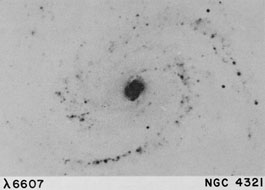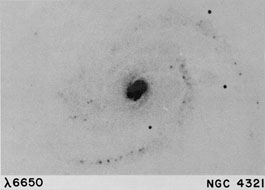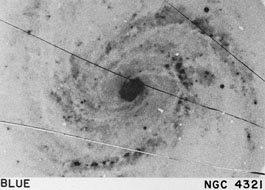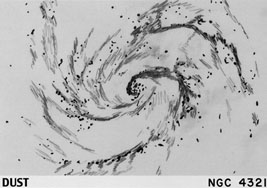


NGC 4321. - This galaxy may be considered a prototype for the regularities that exist in Sc's with respect to the distribution of dust and HII regions. In M100 there are bright knots (Morgan's "hot spots" in the nucleus), although for this Sc galaxy the nucleus is brighter in the red than are the hot spots.
Outside this central core the dust lanes dominate in defining a
two-armed spiral pattern. The galaxy is unusual in that the
H photograph shows HII regions strung along the emerging dominant spiral
arm defined by the dust. This distribution is in contrast to the
pattern defined by the bright blue arm clearly seen in the Hubble
atlas print or the negative print in Sandage's article
(1958). Note
also the other "prototype" features of the spiral pattern:
photograph shows HII regions strung along the emerging dominant spiral
arm defined by the dust. This distribution is in contrast to the
pattern defined by the bright blue arm clearly seen in the Hubble
atlas print or the negative print in Sandage's article
(1958). Note
also the other "prototype" features of the spiral pattern:
1. Two major arms are defined by the dust but one is much more regular and clear than the other. On this dominant lane can be found a regular string of HII regions; often in or on the outer edge of the dust (inner edge of the bright arm), but sometimes HII regions are found in the outer edge of the bright arm or along a "feather" of dust which characteristically cuts across the arm at angles of about 60° to the primary lanes.
2. The less regular primary arm has irregular distribution of HII regions which are characteristically distributed along the feathers rather than along the outer edge of the primary lane. These HII regions are frequently less luminous than the one associated with the regular lane.
3. A few interarm HII regions are detected; these are usually much fainter than those clearly associated with the two main arms.
As has been pointed out by
van der Kruit (1973),
NGC 4321 is very
similar to NGC 5194. Van der Kruit explains this by showing that the
available data indicate strong density-wave compressions for both
objects. A partial rotation curve was published by van der Kruit; the
outer (50"-100" from the center) velocities were based on measurement
of H and [NII]
and [NII]
 6583 for the western arm,
which is the less regular
of the two primary spiral arms. It would be most interesting to test
the symmetry of velocities by measuring comparable velocities in the
regular arm.
6583 for the western arm,
which is the less regular
of the two primary spiral arms. It would be most interesting to test
the symmetry of velocities by measuring comparable velocities in the
regular arm.

| 
|

| 
|